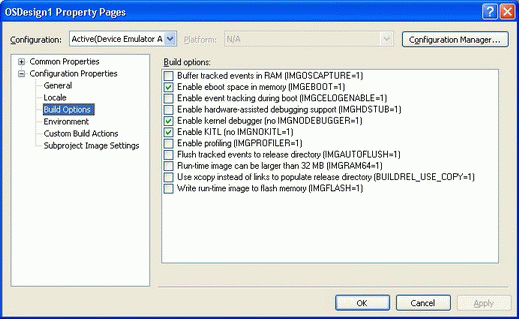Книга: Microsoft Windows Embedded CE 6.0 Exam Preparation Kit
Build Options
Build Options
Directly under the Locale node in the Property Pages dialog box, you can find the Build Options node, which enables you to control event tracking, debugging, and other build options for the active OS design, as illustrated in Figure 1-3.

Figure 1-3 Build Options property page
The Build Options property page enables you to configure the following options for the run-time image:
? Buffer Tracked Events In RAM Causes Platform Builder to include OSCapture.exe in the CE image. Also enables logging of operating system events tracked by OSCapture.exe in RAM so they can be flushed to a file and viewed later.
? Enable Eboot Space In Memory Enables the Ethernet boot loader (EBOOT) to pass data to the Windows Embedded CE OS at start time.
? Enable Event Tracking During Boot Enables CE event log data collection much earlier during the start process than it would normally be collected otherwise. If you activate this option, event tracking starts before most of the kernel and file system initialization is complete.
? Enable Hardware-Assisted Debugging Support This is required for some third- party hardware debugging tools (JTAG probes compliant with exdi2).
? Enable Kernel Debugger Enables the Windows Embedded CE debugger so you can step through the code in the run-time image. Kernel debugging requires KITL to communicate with Platform Builder at run time.
? Enable KITL Adds KITL to the run-time image. KITL is a useful debugging feature that enables developers to use the kernel debugger, interact with the remote device's file system, registry, and other components, as well as run code. You should not include KITL in the final build of the operating system, because it introduces overhead and wastes time during the start process trying to connect to a host computer.
? Enable Profiling Enables the kernel profiler in the run-time image, which you can use to collect and view timing and performance data. The kernel profiler is a useful tool for optimizing the performance of Windows Embedded CE on a target device.
? Flush Tracked Events To Release Directory Adds CeLogFlush.exe to the runtime image, which automatically flushes log data collected by OSCapture.exe to the Celog.clg file in the release directory on the development computer.
? Run-Time Image Can Be Larger Than 32 MB Enables you to build a larger-than-32-MB image. However, you should not use this option if you want to build an image larger than 64 MB. In this case, you must set an environment variable for the appropriate size (such as IMGRAM128).
? Use Xcopy Instead Of Links To Populate Release Directory Creates actual copies of the files by using xcopy rather than copylink. Copylink might only create hard links to the files rather than copying them, and it requires the NTFS file system on the development computer.
? Write Run-Time Image To Flash Memory Instructs EBOOT to write the run-time image to the flash memory of the target device.
- Two Handy Options
- 4.3. Kernel Build System
- 4.3.5. Custom Configuration Options
- Appendix D. TCP options
- What is needed to build a NAT machine
- LOG target options
- Configuration options
- fwbuilder
- Chapter 2 Building and Deploying a Run-Time Image
- The Menu Options
- 10.1.5 The Options Menu
- Building the Source Yourself




